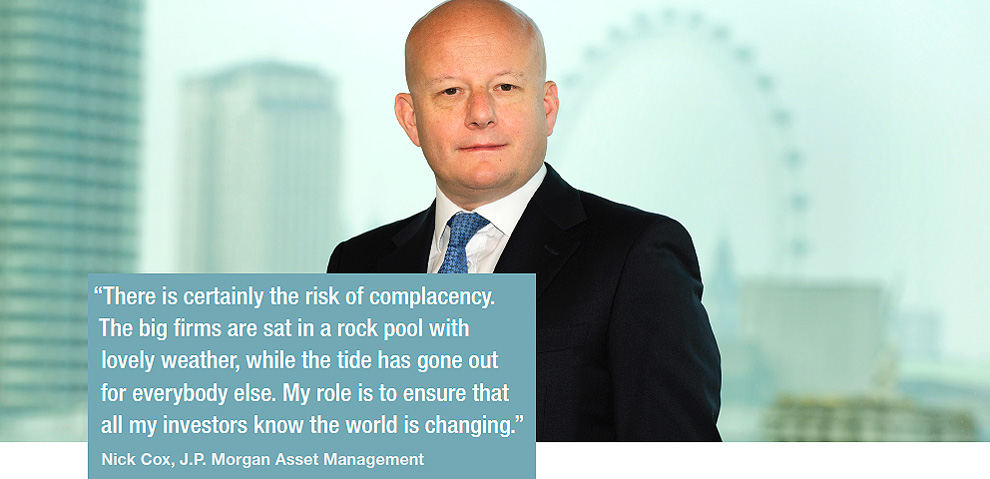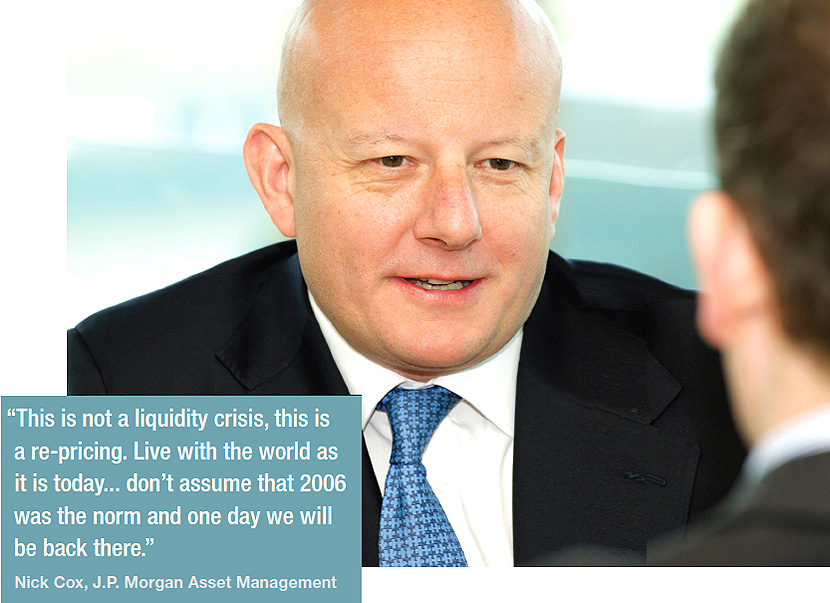Nick Cox: Engaging a moving target
Nick Cox is the global head of fixed income trading at J.P. Morgan Asset Management, one of the largest buy-side firms in the world with US$1.8 trillion in assets under management. Appointed in April 2014, he is responsible for trading worth hundreds of billions of dollars a year, managing the firm’s desks in the US, UK, Europe and Asia.

What are your strategic priorities in the role, one year in?
My strategic priorities are around developing our platform. We want to make connectivity across it more sophisticated than people sending emails and Bloomberg messages. Mike Urciuoli joined J.P. Morgan Asset Management as chief technology officer a little before I joined, and we are looking at how we take a platform that has been focussed on ‘buy’ rather than ‘build’, and instead take the optimal approach in order to make things more fit-for-purpose and more scaleable.
A large part of my focus is the plan for our investment in trading technology over the next two to three years. It is complicated by the fact that credit market structure is still in a state of flux so the target market paradigm is still poorly defined. We want to make investments which move our platform forward but don’t tie us into technology [that later becomes outdated].
Credit markets are just at the start of the evolution and we know that of the numerous initiatives there aren’t going to be 40 or 50 platforms which survive, there might be four or five. It’s a question of letting market forces figure out what succeeds. In comparison with other asset classes, what credit investors want from trading and information platforms varies significantly.
If a macro event hits the markets – a rate hike or sovereign re-rating – what do you need to look at to manage your team?
My responsibility is to make sure we can access liquidity in markets which may be quite febrile. We saw events in October 2014 with the move in US treasuries, and earlier this year with European currencies. That is my challenge. A big part of that is ensuring that our platform is robust but also that we have strong and deep relationships with our liquidity providers.
How do you track your team’s performance?
Managing performance of traders at buy-side firms is always hard. Some hedge funds operate with a couple of traders tied to an individual portfolio manager (PM), and are compensated very directly based on that PM’s out-performance and implementation shortfall.
Given the size and complexity of our business that’s not feasible and I am not sure it’s desirable. It effectively creates a brokerage model within the firm. We want people to be incentivised to produce the best outcomes for all of our clients and not just for generating some kind of nominal internal commission number. It’s not a black and white answer and that reflects the qualitative side is just as important as the quantitative side.
Are there metrics or tools to help?
There is an immediate and very short feedback loop to our internal clients and portfolio managers. That provides crisp feedback if they feel the traders are not doing a good job, and we try to cross-fertilise best practice between teams.
The ability to provide transaction cost analysis like that established in the equity world is limited; as you go down the liquidity spectrum in asset classes it is very hard getting the appropriate level of reference data. It’s something that we are working with a number of providers and we are trying to move the needle forward. But it’s difficult.
How are you developing tools to help your traders?
We have tended to buy rather than build and we are reviewing that. While we are evaluating systems, market structure is evolving. There are somewhere between 30 and 50 various initiatives trying to address the liquidity challenge [in credit]. We are engaged with a handful of those that we think are more promising and have a greater chance of success, but there are many low delta options.
If I was given a very large cheque and told I have two years to go and build a system to interface with the credit markets, but it has got to last for 10 years, with no more money to come, that would be a hard thing for me to do. It would be hard to know which horse to back. So we can only move ahead as quickly as the rest of the industry does. In the rates markets there is more clarity.

Around liquidity and better information flow, my trading problem falls into two buckets. One contains super-liquid, high-volume products where the business is about efficient execution, building the plumbing and the tools so we have that scaleable platform. The other bucket is less about the actual execution and more about inventory discovery, trying to find liquidity.
Technology is addressing both problems; the second is more transformative but understanding what is liquid and what is not and having that information delivered electronically is as much about a portfolio management tool as a trading tool. Portfolio managers want to know which security is liquid and traders want to know who is offering it. Our traders are part of the investment process, part of the investment team.
What are the skills you look for in your team?
The primary skill you want in a buy-side trader is understanding liquidity, its sources and at a thematic level understanding what generates the ebb and flow. Right now there is a re-pricing of liquidity so a trader’s ability to understand liquidity, while always important, is becoming increasingly significant. Some people may say that – pre-crisis and pre-regulatory reform – liquidity was too cheap. Now it is moving back to a normal level or possibly through what is a long-term normal level. We have to manage money in whatever weather we have.
How does the changing market structure impact performance?
Capital rules have impacted liquidity in the corporate bonds secondary market, liquidity that applies to everyone. That has impacted transaction costs and maybe that in turn means certain active strategies aren’t profitable anymore because the theoretical alpha gets eaten away by the transaction costs. But that’s the new normal and you have to come up with different strategies to generate alpha in different ways. Your investment processes and alpha strategies have to evolve in the context of where market liquidity is.
Is there a risk that fewer strategies increases uniformity of performance and strategy between firms?
It has always been the case that a firm has an insight, generates decent alpha for a number of years, then as people leave they effectively take that intellectual property with them. Ever since I have been in the markets that has been the case, which is why any return-generating organisation has to continuously come up with new insights and new sources of alpha.
Can your scale mask the risks that affect the broader market?
I think there is certainly the risk of complacency. That’s one of the things I have to bring to the table. The big firms are sat in a rock pool with lovely weather, while the tide has gone out for everybody else. My role is to ensure that all my investors know the world is changing for everyone and whilst we have strong and deep relationships that help our ability to execute, we need to be aware that the tide is going out. But as I say, this is not a liquidity crisis, this is a re-pricing. Live with the world as it is today, take informed views about what you think the future track will be, but don’t assume that 2006 was the norm and one day we will be back there.
Who do you see making a positive change?
I think that has to come from the buy-side industry. Some of the less positive outcomes from things like MiFID II impact the whole industry irrespective of your investment style and we believe that they may be to the detriment of our end investors, albeit drafted with the best intentions. Speaking with a coherent voice and playing a part in educating regulators is key.
As costs rise, could smaller firms look to larger firms to provide execution?
You run into lots of conflicts of interest with that. It is very hard to see how you could build a commercial model which wouldn’t be disadvantageous to the investors in the buy-side client.
There are market opportunities to provide toolkits which are probably more narrowly focussed in terms of their functional breadth, but which do not actually provide execution services.
It seems that execution in treasuries is facing similar dynamics to the equity market following the 14 October flash crash. How do you manage that sort of event?
This is an awareness issue. While you can’t control the traffic, if you look both ways twice before you cross the road you significantly reduce your odds of being run over. Some of the large buy-side users hadn’t realised that high-frequency traders (HFTs) were as active in the treasury space as they were in equities.
I think the bigger issue in the core rates markets is what the full impact of the leverage ratio regulations will be and what that will do to the very high level of liquidity you get at a very low price. If you have a super-liquid market where you can move significant amounts of capital at very low frictional costs one of the flip sides is you get organisations like HFTs involved.
You have the high-yield credit market where you have low liquidity, high transactions cost and where – funnily enough – you don’t get high-frequency trading. So you have to be careful what you wish for.
©Markets Media Europe 2025












